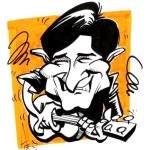Yamaha Pianica 34, P-34
Tagged: P-34, Pianica 34, Yamaha
- This topic has 11 replies, 5 voices, and was last updated 6 years, 3 months ago by
 Andrew Morse.
Andrew Morse.
-
AuthorPosts
-
September 18, 2015 at 6:53 pm #5956
 Alan BrintonParticipant
Alan BrintonParticipantThe Pianica 34 was introduced during the 1960s and was succeeded by the Pianica P-34 by the early 1970s. The instrument shown here is the P-34. I’m showing in some detail because of its rarity and unusual design. Superficially it looks a lot like its contemporary P-32, but its keypads and the configuration of its reed plates are very different from those of the P-32 or other Yamaha that I have examined. This can be more easily shown than explained, so here we go.



The P-34 also has an unusual case, carried over from the Pianica 32 — and a very unique adjustable strap. It’s hard to understand why this design, far superior to the standard strap design, has not been used on other Yamahas or adopted by other melodica makers.

Same rod-style moisture valve mechanism as on several other 1960s-70s Pianicas (and on a few Suzuki Melodions), one of the most effective designs, in my opinion.




So now here we see the bottom of the reed plate, facing up in the photo, down into the metal tray when in place. At this stage of disassembly, the Pianica can be played, but removal of the plates is required for tuning. The tiny screws (2) and nuts were almost all only finger tight, which may explain why the Pianica was less than air tight — I still have it disassembled.





The keys press directly down to push open the key pads and open the air flow.



 September 19, 2015 at 10:53 am #5958
September 19, 2015 at 10:53 am #5958 DarenKeymaster
DarenKeymasterSome similarities to the Clavietta!
September 19, 2015 at 2:12 pm #5959 Alan BrintonParticipant
Alan BrintonParticipantI noticed.
September 20, 2015 at 12:03 am #5960 Alan BrintonParticipant
Alan BrintonParticipantThe more closely I’m looking at this in trying to address its leakiness, the more similarity I see with the 34 key Clavietta. It has to be Yamaha’s answer to the Clavietta. Too much air is leaking to make meaningful sound comparisons, yet this Pianica is to all appearances more solidly constructed than a Clavietta and in much better condition that the three of those I have examined.
If you look at the last photo above, you see the chambers for each individual key. When the key is depressed, the plunger is raised (from this bottom side view), and air escapes and hits the reed side of the reed plate. By placing my lips over the opening, I can tell by blowing and sucking that the seals on all these plungers are fine — no air is escaping in either direction. So, unlike the situation with an old Clavietta, there’s no need for replacement of decomposed pads or washers, which is very good news. The plunger rod in each case runs from the key through a metal plate which is less than 1/4 inch (I’m estimating) from the bottom (from above in the picture) of the individual reed chamber. This means that the main air chamber that runs the length of the Pianica is very thin. Air must be escaping either from this chamber or from the vent end of the spit valve mechanism or thereabouts.
Opening the main air chamber will require removal of all the keys. I think some air is escaping from the vent end of the spit valve mechanism. I’m just thinking out loud here, but someone may have insight to offer. I’m still experimenting and don’t want to be hasty about removing all the keys, etc.
September 21, 2015 at 7:01 pm #5975 Alan BrintonParticipant
Alan BrintonParticipantThe smoke test demonstrates that I was mistaken about the plunger seals. Most of the ones near the mouthpiece end allow smoke through, and well as some others further up the keyboard. No smoke escapes anywhere else. I have too many other things going on right now to remove the keys and further disassemble, but it looks like that’s what will be required.
September 22, 2015 at 12:28 pm #5978 Shannon MParticipant
Shannon MParticipantAlan,
I wonder if the caps over the plunger seals unscrew, as on the Clavietta. This should allow changing the seals without completely disassembling the keyboard. From your pictures, I am not sure removing the keys will improve access.
September 22, 2015 at 3:53 pm #5979 Alan BrintonParticipant
Alan BrintonParticipantThanks for your observation, Shannon. This helps. I won’t just start removing all the keys. At first it seemed to me that the plunger shaft screws directly into the bottom of the key, but now it looks, upon closer inspection, as though there is a little disk (like a nail head) at the top of the shaft that slides into position in a receptacle on the bottom of the key, so that when the key spring is removed, the key shaft can be freed from the key, after which I suppose the plunger may be removable from the other end. It may be more complicated than that, but the best approach is probably to remove one or two keys and see.
July 21, 2017 at 6:21 pm #9079Paul Durham
ParticipantI located your thread on the P-34. Clearly a little later than the seller in the Ebay auction may be thinking. Your photos show the Yamaha branding. Not able to see this in auction photos. I have a small bid but I won’t really be disappointed to be outbid because from your comment this sounds like the new owner needs to be ready to do repairs. With one hand I don’t think I’m up for that.
July 21, 2017 at 9:23 pm #9080 Alan BrintonParticipant
Alan BrintonParticipantIt was designed and manufactured by Tokai Gakki and appeared both under that name and as a Yamaha. Mine is still apart. Maybe I’ll take another shot at getting it working.
January 16, 2018 at 12:09 am #9612 Andrew MorseParticipant
Andrew MorseParticipantI just aquired two of these via shopgoodwill for $15 each shipped. One came in very good condition apart from some nasty tape residue and other assorted crud. The other had a seriously cracked mouthpiece hole but fortunately no missing bits so I was able to easily glue and clamp it back together with some epoxy and smooth it out with fine sandpaper.
I took them both apart, cleaned the keys and outer case with hot water and a mild abrasive cleanser and a 3m sponge which removed the tape and other crud. They both play well and in tune too! The more damaged one actually had better tuning but they both are acceptable.
I was impressed with the simple design and how easy they were to take apart, remove the keys, clean and access the reed plates for tuning. The angled strap is very comfortable to hold when playing in a more vertical orientation. The reeds respond well to choking / bending and vibrato type air effects.
The valves are metal disks and posts with a rubber gasket. Spring tension on the key keeps them closed. There was some black dampening material on the square end of the posts which feed into slots on the underside of each key. When the square valve head is aligned parallel to the slot, the key slides off the valve post freely. A small floating washer and a felt disk between the valve stem and the entrance to the valve chamber provides cushioning and damping of key noise.
Underneath the felt disk, the post passes through a small washer which is glued to the top of the keybed. The valve side of the reed chamber is a disk with a serrated edge. It might be that this can be unscrewed but I was afraid to attempt this and break one.
They both came with tube mouthpieces, but only one had the hard plastic one. I am on the hunt for a suitable sized replacement. I will take a inner and outer diameter measurement and report back. If anyone has one of the current yamaha mouthpieces, perhaps they could check diameter measurement and let me know?
January 16, 2018 at 1:38 am #9613 Alan BrintonParticipant
Alan BrintonParticipantGood finds! I’m not sure I would agree that the design is simple, but it is elegant and well thought out.
I don’t have my P-34 handy, but I think the mouthpiece is the same as for the Pianica 32A. If so, a mouthpiece from a current model (P-25F, P-32D. P-37D) will work, though it’s a tight fit. But if you haven’t tried playing without a mouthpiece, try that. I like playing these without one. For those who are looking for a current Yamaha mouthpiece, I usually suggest just buying a P-25F if you don’t already have one. Everybody should have one!
January 18, 2018 at 12:20 am #9614 Andrew MorseParticipant
Andrew MorseParticipantThanks for the advice!!
You are right on the Pianica 32A It has the same shape and the soft rubber outer skirt that mine does. Looks like a good fit. I will do some searching around for one of those. I will give the no mouthpiece thing a try too. That could work with a vertical orientation.
Interestingly, mine are branded “Artist Ltd. Pianica” but are exactly the same. The case is the same blue and white scheme and are marked P-34
-
AuthorPosts
- You must be logged in to reply to this topic.
